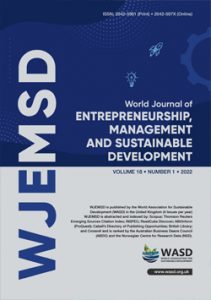Assessing the factors of employees’ intrapreneurial behaviour: an Indian context, Sunayana Kumar and Rakhshanda Parveen
 Sunayana Kumar, Rakhshanda Parveen
Sunayana Kumar, Rakhshanda Parveen
Centre for Management Studies
Jamia Millia Islamia Central University, New Delhi
India
Email: rakhshanda_93@outlook.com
DOI: 10.1108/WJEMSD-12-2020-0160
Purpose: This paper evaluates the factors that help in enabling the intrapreneurial behaviour amongst the employees according to their importance. This study will evaluate the relationship between these factors and intrapreneurship. It will also provide a significant contribution in understanding what it takes to be among India's best companies.
Design/methodology/approach: This study incorporates a quantitative approach where the data has been collected through the “Great Place to Work” Institute's list of top companies in India to work for. The final sample included 109 employees from 50 companies. Correlation and regression analyses are used for data analysis.
Findings: The results indicated that there is a positive and significant effect of the environment and organizational factors on intrapreneurship. Within the individual factors, management support in organizational factors and technological opportunities present in the market (environmental factors) are perceived as the most important factors for intrapreneurial activities. Additionally, “self-renewal activities” are considered as an important intrapreneurial activity for the respondents.
Originality/value: The results of this study are significant because the sample is taken of the companies already known for their workplace culture. This helped in cross-validating the results.
Keywords: Great place to work; Innovation; Intrapreneurial activities; Intrapreneurship; Linear regression analysis; Management support; Organizational learning; Technological opportunities; Workplace culture.
Citation: Kumar, S. and Parveen, R. (2021), "Assessing the factors of employees' intrapreneurial behaviour: an Indian context", World Journal of Entrepreneurship, Management and Sustainable Development, Vol. 17 No. 4, pp. 804-821. https://doi.org/10.1108/WJEMSD-12-2020-0160

